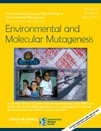Stiborova M, Mares J, Frei E, Arlt VM, Martinek V, Schmeiser HH. Environ Mol Mutagen. 2011 Jul;52(6):448–59. doi: 10.1002/em.20642. Epub 2011 Mar 2. IF: 3,493

Abstract:
Ingestion of aristolochic acid (AA) is associated with development of urothelial tumors linked with AA nephropathy and is implicated in the development of Balkan endemic nephropathy-associated urothelial tumors. We investigated the efficiency of human NAD(P)H:quinone oxidoreductase (NQO1) to activate aristolochic acid I (AAI) and used in silico docking, using soft-soft (flexible) docking procedure, to study the interactions of AAI with the active site of human NQO1. AAI binds to the active site of NQO1 indicating that the binding orientation allows for direct hydride transfer (i.e., two electron reductions) to the nitro group of AAI. NQO1 activated AAI, generating DNA adduct patterns reproducing those found in urothelial tissues from humans exposed to AA. Because reduced aromatic nitro-compounds are often further activated by sulfotransferases (SULTs) or N,O-acetlytransferases (NATs), their roles in AAI activation were investigated. Our results indicate that phase II reactions do not play a major role in AAI bioactivation; neither native enzymes present in human hepatic or renal cytosols nor human SULT1A1, -1A2, -1A3, -1E, or -2A nor NAT1 or NAT2 further enhanced DNA adduct formation by AAI. Instead under the in vitro conditions used, DNA adducts arise by enzymatic reduction of AAI through the formation of a cyclic hydroxamic acid (N-hydroxyaristolactam I) favored by the carboxy group in peri position to the nitro group without additional conjugation. These results emphasize the major importance of NQO1 in the metabolic activation of AAI and provide the first evidence that initial nitroreduction is the rate limiting step in AAI activation.
-mk-